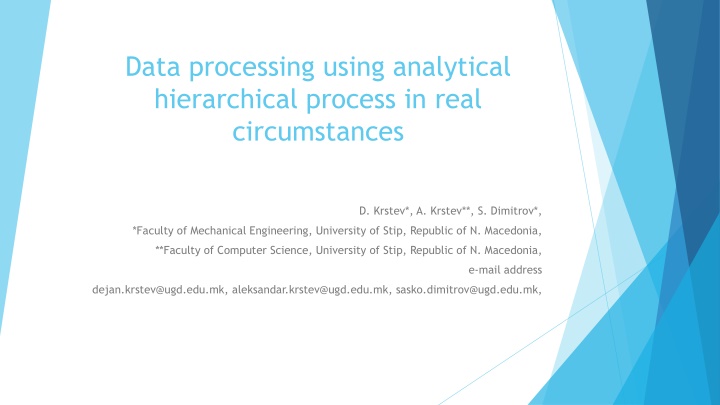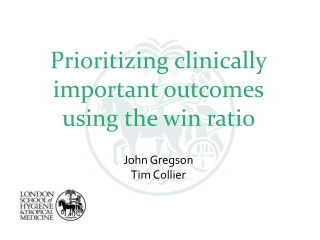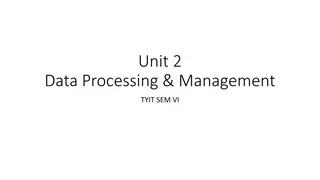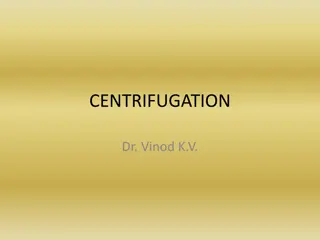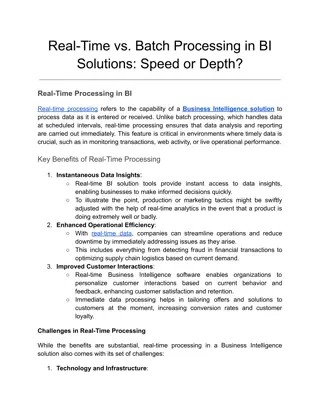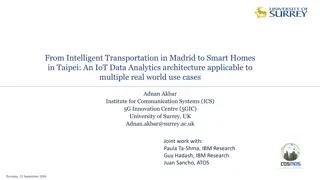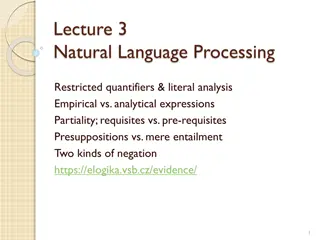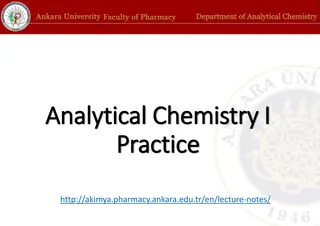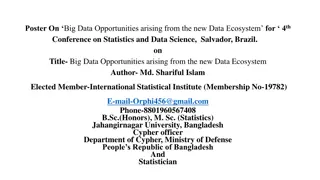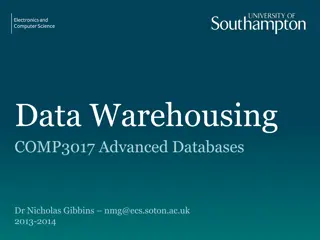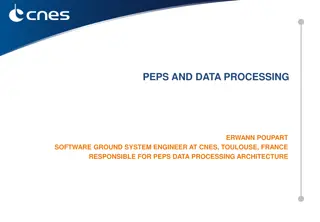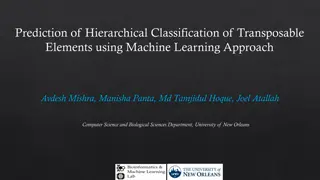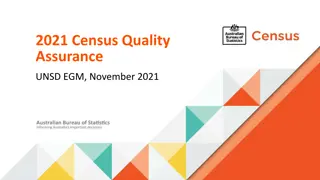Data Processing Using Analytical Hierarchical Process in Real Circumstances
In the development of small and medium enterprises, optimizing management activities is crucial. This study explores modern methods for data processing and analysis, focusing on supply chain management and business logistics. Multi-criterion optimization is discussed to find favorable solutions considering various criteria. The importance of logistics in the modern economy is highlighted, showcasing the impact on productivity, inflation, and overall economic aspects.
Download Presentation

Please find below an Image/Link to download the presentation.
The content on the website is provided AS IS for your information and personal use only. It may not be sold, licensed, or shared on other websites without obtaining consent from the author.If you encounter any issues during the download, it is possible that the publisher has removed the file from their server.
You are allowed to download the files provided on this website for personal or commercial use, subject to the condition that they are used lawfully. All files are the property of their respective owners.
The content on the website is provided AS IS for your information and personal use only. It may not be sold, licensed, or shared on other websites without obtaining consent from the author.
E N D
Presentation Transcript
Data processing using analytical hierarchical process in real circumstances D. Krstev*, A. Krstev**, S. Dimitrov*, *Faculty of Mechanical Engineering, University of Stip, Republic of N. Macedonia, **Faculty of Computer Science, University of Stip, Republic of N. Macedonia, e-mail address dejan.krstev@ugd.edu.mk, aleksandar.krstev@ugd.edu.mk, sasko.dimitrov@ugd.edu.mk,
Abstract In the development of the industry of small and medium enterprises that are involved in one of the most specific activities such as working with products, materials it gives and seeks opportunities for optimizing the basic management activities in the work of a company. Today, many data are constantly generated that require proper processing and access to them, especially when it comes to supply chain management and business logistics. Standard processing techniques may not meet these requirements. The development of information technology and decision theory has contributed to the emergence of the application of modern-applicable methods and approaches to data processing and analysis. The way of processing data from traditional data processing tools are adapted for data processing and with the help of tools and mathematical methods that enable processing and analysis of big data that depend on several criteria such as time, resources, quality, and distance when it is about delivering work material. The identification and analysis of the problem to be solved, the determination of the possible solutions to the problem, the criteria according to which the possible solutions are evaluated, i.e., the alternatives and the choice of the best possible solution is a decision- making process. It is the choice of the best, from the most possible alternative solutions to the problem such as the problem of delivery of specific material such as leather considering the quality and price. Keywords: data processing, supply chains, data, decision making, analysis, mathematical methods.
INTRODUCTION Logistics in the modern world is becoming a current issue to which more attention is paid. In many countries with developed market economies, the share of logistics activities in the formation of gross national product exceeds 20%, which directly affects all aspects of the economy (inflation, productivity, interest rates, etc.). This is one of the main reasons for the increased interest in this issue. In the field of logistics, you can find several terms such as: materials management, physical distribution, business logistics, logistics management (synonymous with business logistics), supply chain management and others. All these terms explain the same area - logistics. This fact is positive, because it provides great flexibility to companies in terms of changing the product range, production of small batches and short delivery time of the final product. This is a key factor for successful cooperation with foreign partners and for the survival of this branch which is under constant pressure from competition and market laws.
RESEARCH METHODOLOGY Multi-criterion optimization is an area where a mathematical model is formed for a particular mathematical problem, considering multiple goals at the same time. It is essential that the most favourable alternative solution be found according to all the criteria considered, which can be expressed in different units of measure, different currencies, different probabilities of occurrence or subjective estimates. The task of multi-criteria decision optimization is in cases where important decisions are considered and made, such as capital investment decisions, which are characterized by a relatively large number of criteria. For effective analysis of decisions and finding an appropriate solution, the criteria are selected and grouped into economic, technical, technological, social, and environmental criteria. Models that form a mathematical model for a real problem from the beginning consider multiple criteria simultaneously and develop in the field of multi-criteria optimization. Many criteria in the models of multi-criterion optimization mean not only the realization of modelling, but also increasing the reliability of the obtained results. The disadvantages of multi-criteria optimization are the consideration of several criteria and the way they define weights in the model, which in turn makes this process of mathematical modelling complex. The development of multi-criteria optimization methods started with problem solving step by step, i.e., methods for specific problems were developed. Defining the effects of weights in the model of this process with mathematical modelling makes it complex in today's conditions of development of mathematics as a science. There are a few optimization methods and other quantitative mathematical methods that can be applied to problem solving and decision making in the planning and design processes in industry.
METHODS OF DECISION MAKING AND THEIR APPLICATION Mathematical-model optimization methods have been developed for solving problems in planning and design in the different fields, which consists of preparatory work for defining and developing the mathematical model. From this set of modelling methods, from the position of application, the following groups can be distinguished: Models of one-criteria optimization are: linear programming, nonlinear programming, dynamic programming, etc. Models of multi-criterion optimization are: AHP method, ELECTRA method, PROMETHEE method, VIKOR method and others. These methods belong to the group of multi-attribute decision making methods. Working with them is different depending on how the models are calculated and the input data (alternatives and criteria). AHP Method - The Analytical Hierarchical Process (AHP)
MATERIAL AND METHOD OF OPERATION Analytical hierarchical process (AHP) is based on the concept of balance used to determine the overall relative importance of a set of attributes, activities or criteria and refers to the analysed problem with the decision. This can be achieved by structuring any complex decision-making problem, involving multiple individuals, multiple criteria, and multiple periods at several hierarchical levels, assigning weights in the form of a series of double-piece matrices, and then using Expert decision support system to determine normalized weight. These estimate the attributes at the lowest level of the entire hierarchy. The thus understood process of modelling includes four stages: Problem structuring, Data collection, Relative weight assessment and determining the solution problem structuring stage consists of breaking down a complex problem of decision-making into a series of hierarchies where each level represents a smaller number of managed attributes. Then, they break down into another set of elements that correspond to the next level and in the same order as Figure 1. weights are used to AHP Scale of Importance for comparison pair (aij) Extreme Importance Very strong to extremely Very strong Importance Strongly to very strong Strong Importance Moderately to Strong Moderate Importance Equally to Moderately Equal Importance Numeric Rating Reciprocal (decimal) 9 8 7 6 5 4 3 2 1 1/9 (0.111) 1/8 (0.125) 1/7 (0.143) 1/6 (0.167) 1/5 (0.200) 1/4 (0.250) 1/3 (0.333) 1/2 (0.500) 1 (1.000) to the problem. The
RESEARCH STUDY USING THE METHOD OF ANALYTICAL HIERARCHICAL PROCESS (AHP) The main purpose of this paper is to propose a modern scientific methodology such as (AHP) that will be used in selecting the most favourable producers and suppliers of different materials for a company, using the methods for multicriteria decision making as a modern approach uses analyse the problem. to identify alternatives (variant solutions). selection of criteria and definition of their weights. to transform the qualities of the attributes (criteria). making a multi-criteria model. solving the model and determining the optimal solution. No. 1 2 3 4 Alternative Mark A1 A2 A3 A4 Istanbul - manufacturer and supplier Thessaloniki - manufacturer and supplier Belgrade - manufacturer and supplier Durres - manufacturer and supplier Defining criteria for multi-criteria decision making: To solve the problem, it is necessary to analyse the technical-economic parameters by making a model for selection manufacturer and supplier of material, according to a multi-criteria decision-making method. In our case, four alternative hypothetical models of material manufacturers and suppliers are given, which should be used for an industrial process in which chemical preparations with their basic characteristics are used: Criteria 1 - Price of material by appropriate quantity, of an appropriate Criteria 2 - Material performance ("positive" properties), Criteria 3 - Delivery time, (hours), Criteria 4 - Location (distance from production site to industrial plant) (km), Criteria 5 - "Material quality" according to the method (appearance/tones).
SOLVING A MULTI-CRITERIA MODEL IN SELECTING THE BEST MANUFACTURER AND BIDDER ACCORDING TO THE REQUIREMENTS OF A COMPANY TABLE 3. REAL DATA FROM THE BIDDERS The calculation methodology uses the AHP method for multi-criteria decision making described in the previous chapters. The data used for this illustration of problem solving are hypothetical. At the beginning, a decision matrix is formed with quantitative and qualitative assessments of the criteria that were considered as input data of the model, during processing the following matrix is obtained. Alternatives Criteria 3 min 9,10 2,53 4,40 3,45 1 min 3100 6250 5910 4560 2 max 1,5 1,4 1,2 1,1 4 min 814 237 432 242 5 max Goal 1 2 3 4 Very High High Average Average TABLE 4. NINE-POINT SCALE ACCORDING TO SAATY WITH NUMERICAL VALUES Qualitative assessment Quantitative assessment Very low Low Average High Very High Type of criteria max min 1 9 3 7 5 5 7 3 9 1 TABLE 5. NINE-POINT SCALE ACCORDING TO SAATY WITH NUMERICAL VALUES PRESENTED IN THE REAL DATA FROM THE BIDDERS Alternatives Criteria 3 min 9,10 2,53 4,40 3,45 1 min 3100 6250 5910 4560 2 max 1,5 1,4 1,2 1,1 4 min 814 237 432 242 5 max 9 7 5 5 Goal 1 2 3 4 TABLE 7. DATA INTERACTION AND CRITERIA WEIGHT Criteria Criteria weight 0,336 1 KxA1 A2 KxA2 A3 KxA3 A4 KxA4 TABLE 8. FINAL RANKING OF THE ALTERNATIVES K1 0,490 0,338 0,097 0,074 Total Rank 0,165 0,114 0,033 0,025 K2 0,378 0,418 0,383 0,116 0,083 1 0,158 0,144 0,044 0,031 0,440 1 K3 0,145 0,442 0,392 0,096 0,070 2 0,064 0,057 0,014 0,010 0,380 2 K4 0,056 0,370 0,455 0,097 0,078 3 0,021 0,026 0,005 0,004 0,104 3 K5 0,084 0,381 0,459 0,094 0,065 4 0,032 0,440 0,039 0,380 0,008 0,104 0,006 0,077 0,077 4 Total
CONCLUSION This paper presents a process of optimal selection of procurement of materials for the needs of a small and medium enterprise dealing. The AHP method as a method for multi-criteria evaluation and selection has been used for the research conducted in this paper. The method is first explained theoretically, all the procedures by which it is used in everyday decision-making in the logistics process. The main problem with the application of this method is the definition of decision- making attributes in the second level of the hierarchical structure for the selection of criteria and the assessment of their relative weights. The definition of alternatives is based on the budget and the basic requirements of the end user that would meet the basic criteria for production considered when choosing a suitable supplier of suitable material. After the assessment it is shown that the best supplier is the Istanbul supplier even, although it is the furthest place based on its location, but it is more financial and quality suitable for the enterprise. Final ranking of the alternatives are showing the advantage of Istanbul as most adequate alternative for enterprise dealing.
